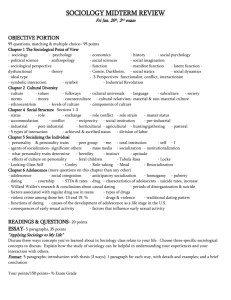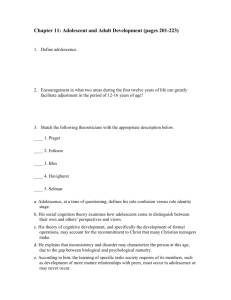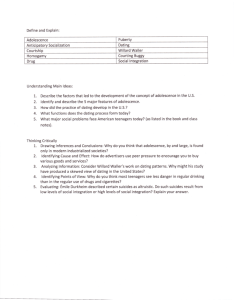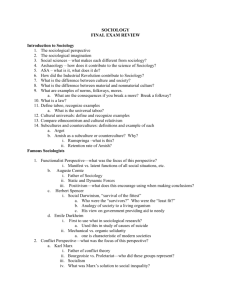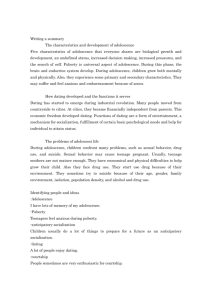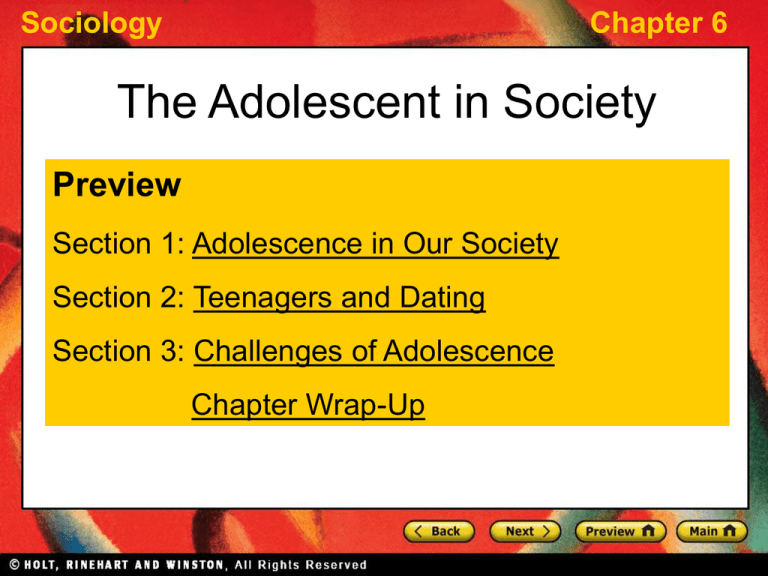
Sociology
Chapter 6
The Adolescent in Society
Preview
Section 1: Adolescence in Our Society
Section 2: Teenagers and Dating
Section 3: Challenges of Adolescence
Chapter Wrap-Up
Sociology
Chapter 6
Section 1: Adolescence in Our Society
Read to Discover
• How did adolescence develop as a distinct
stage of the life cycle in the United States?
• What are the five general characteristics of
adolescence?
Sociology
Chapter 6
Section 1: Adolescence in Our Society
Question
How did adolescence develop as a
distinct stage of the life cycle in the
United States?
Sociology
Chapter 6
Section 1: Adolescence in Our Society
Prior to 1860s
Adolescence did not exist as a
separate life stage; children treated
as small adults
Education
Children stay in
school longer;
extended period
of dependence
Work
Laws restricted child
labor, also increasing
length of dependency
Courts
Juvenile-justice
system legally
distinguished between
youth and adults
Effect
Development of adolescence as a distinct life
stage between childhood and adulthood
Sociology
Chapter 6
Section 1: Adolescence in Our Society
Five General Characteristics of Adolescence
• Biological Growth and Development—various
biological changes such as changes in body
proportions and acne
• Undefined Status—expectations for
adolescents are often vague
• Increased Decision Making—must make some
of their own decisions
Sociology
Chapter 6
Section 1: Adolescence in Our Society
Five General Characteristics of Adolescence
• Increased Pressure—adolescents are faced
with pressure from many sources
• The Search for Self—deciding what is really
important
Sociology
Chapter 6
Section 2: Teenagers and Dating
Read to Discover
• How did dating develop as a form of social
interaction?
• What functions does dating fulfill?
Sociology
Chapter 6
Section 2: Teenagers and Dating
Question
How did dating develop as a form of
social interaction?
Sociology
Chapter 6
Section 2: Teenagers and Dating
• Industrial Revolution—People moved from the
farms to the cities where young adults could
gain more economic freedom and establish their
own homes. As a result, parental control over
young adults and courtship decreased.
• Public Education—By the 1900s, most
secondary school students attended
coeducational public schools which increased
interaction between boys and girls.
Sociology
Chapter 6
Section 2: Teenagers and Dating
• Automobile—Young adults had more freedom
of movement without their parents.
• Telephone—Young adults could more easily
talk to members of the opposite sex.
• Equality of Women—More women entered the
workforce and took on active community roles,
which increased the interaction between single
adult men and women.
Sociology
Chapter 6
Section 2: Teenagers and Dating
Question
What functions does dating fulfill?
Sociology
Chapter 6
Section 2: Teenagers and Dating
• Serves as a form of entertainment
• Is a means of socialization that teaches people
about the opposite sex and social situations
• Helps teach role behaviors and define self-concepts
• Fills psychological needs such as companionship
• Helps individuals attain status, as people are judged
in part by whom they date
• Aids in spouse selection
Sociology
Chapter 6
Section 3: Challenges of Adolescence
Read to Discover
• What are some of the social problems
facing contemporary teenagers?
• What are the causes and consequences of
these problems?
Sociology
Chapter 6
Section 3: Challenges of Adolescence
Social Problems of Contemporary Teenagers
• Teenage Sexual Behavior
• Teenage Drug Use
• Teenage Suicide
Sociology
Chapter 6
Section 3: Challenges of Adolescence
Question
What are the causes and
consequences of social problems
facing contemporary teenagers?
Sociology
Chapter 6
Section 3: Challenges of Adolescence
Increased Sexual Activity
• Causes—societal loosening of norms concerning
sexuality; birth control; increased exposure to
sexual references and discussion in popular
culture; low income level; single-parent families;
lowered religious participation
• Consequences—teenage pregnancy; emotional
stress; exposure to STDs such as syphilis and
AIDS
Sociology
Chapter 6
Section 3: Challenges of Adolescence
Drug Use
• Causes—dropping out of school; having friends
who use drugs; social and academic adjustment
problems; hostile family setting; feelings of
rejection
• Consequences—drug addiction; drug-related
violence; criminal record; illness; death
Sociology
Chapter 6
Section 3: Challenges of Adolescence
Suicide
• Causes—depression, confusion, self-doubt;
alcohol or drug use; triggering event such as a
personal loss, family crisis, or perceived failure;
social isolation, living in an underpopulated area;
hostile family environment; cluster effect from
publicized suicides; low social integration with
weakened behavioral norms
• Consequences—death; possible cluster effects
leading to other teenage suicides
Sociology
Chapter 6
Chapter Wrap-Up Understanding Main Ideas
1. Describe the factors that led to the development of the
concept of adolescence in the United States.
2. Identify and describe the five major features of
adolescence.
3. How did the practice of dating develop in the United
States?
4. What functions does the dating process perform today?
5. What major social problems face American teenagers
today?

